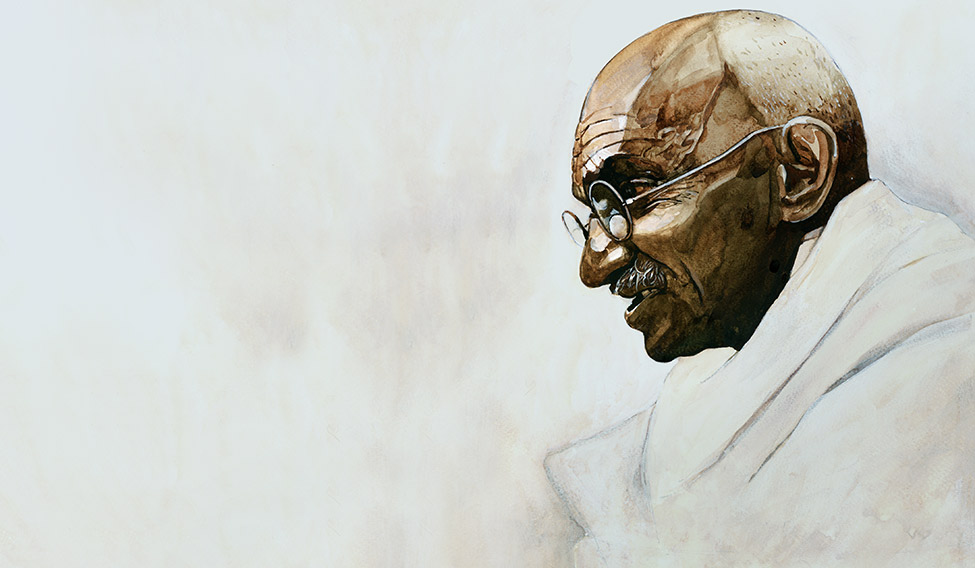Interview/ Dr Pankaj Phadnis
What made you take interest in Abhinav Bharat?
We set up Abhinav Bharat Mumbai in 2002, to write about history, bridge digital divide and promote team sports like hockey and football. In 2008, because of the Malegaon blasts, we came to know that some people had registered another organisation by the same name.
That is Lt Col Purohit’s Abhinav Bharat.
We filed a complaint with the charity commissioner. He said the trust act does not prohibit two trusts being registered by the same name. We filed an appeal in the Bombay High Court in 2011. At that time, the state wanted to ban Abhinav Bharat. So we urged that the court ask the government to clarify which Abhinav Bharat they were talking about. On December 15, 2012, the government filed an affidavit stating that Abhinav Bharat Pune and Abhinav Bharat Mumbai have nothing to do with each other.
I am a mechanical engineer from Indore and I have worked in large multinationals. In 1996, I happened to rent a flat where Veer Savarkar once stayed. When I was in class eleven, [I had read] Freedom At Midnight. In that book Savarkar Sadan is described as a place of malignant radiations. After I started staying there it triggered an interest in me—is this the place where the murder of the century was planned?
So till 1996 there was no interest in history as such.
I was a corporate professional, married with two daughters, and I was researching in my spare time. I ended up writing a book and filing a writ petition in 2004. This was based on my book, Freedom Struggle—The Unfinished Story. The four prayers in my writ petition were:
* We became independent on January 26, 1950 and not on August 15, 1947.
* We were a sovereign nation in 1857 and Bahadurshah Zafar was the nation’s sovereign.
* The freedom struggle was a plural effort, so currency notes should depict all leaders whose portraits adorn the walls of Parliament.
* Primary education was not a fundamental right in 2004. I pleaded for compulsory and free primary education.
Chief Justice Dalveer Bhandari and Justice D.Y. Chandrachud of the Bombay High Court asked the Union government to give me a reasoned order. I still haven’t got it.
In 2007, I published a book, War For Truth, which was released by the eminent jurist Fali Nariman. In 2008, I formed my own company in IT-enabled education. I also did a PhD.
 Connecting gaps: Pankaj Phadnis of Abhinav Bharat Mumbai | Vishnu V. Nair
Connecting gaps: Pankaj Phadnis of Abhinav Bharat Mumbai | Vishnu V. Nair
In 2012, I got some data from British archives indicating that the British could be involved in [Mahatma Gandhi’s murder] because that was a specific allegation made by ambassadors of East Germany, Poland, Hungary and Czechoslovakia to Vijayalakshmi Pandit in a formal condolence meeting when she was Indian ambassador to the USSR. Each ambassador told her that the dastardly murder was planned by the British.
Do you recall their names?
The names are not there. This was a report sent by the British embassy in Moscow to the Foreign Office, London. This telegram is dated February 19, 1948.
Do you have this telegram?
I have enclosed it [with the petition]. Then I came across a secret and sinister agency of the British Crown called Force 136. I also came across a telegram which says that Force 136 had authorisation to kill Netaji Bose.
I had also filed an RTI application in 2004. I got a reply from the Union home ministry, in 2006, that “it appears that the British Crown continued to reign over India till 1950”. All of us believe that we consigned the British Crown to the dustbin on August 15, 1947. I suspect that could also be the reason why the Supreme Court of India has never celebrated August 15 as Independence Day.
The Bombay High Court rejected your petition to re-investigate Gandhi’s murder.
You will first have to see what I am asking for. That is very important.
* Expunge all remarks that refer to Marathi people in general and Veer Savarkar in particular that imply that they/he was in anyway involved in murder of Mahatma Gandhi.
* Appoint a new commission of inquiry to complete the incomplete work of Kapur Commission.
Because Kapur Commission has done excellent work in terms of documenting evidence.
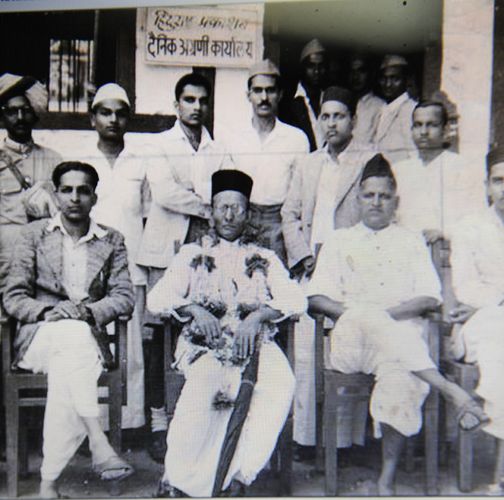 Right aligned: Savarkar flanked by Apte and Nathuram at the launch of Agrani newspaper.
Right aligned: Savarkar flanked by Apte and Nathuram at the launch of Agrani newspaper.
So you don’t want to invalidate the findings of Kapur Commission ?
Only parts, very specific parts about Maratha army which I take serious objection to. I am not asking for exoneration of Godse. Let’s be very clear. He was a murderer he got what he deserved. My only prayer is whatever happened in trial let it remain as it is. If there was someone else involved then please investigate. What I am trying to understand is: Was anybody else—other than those 12 accused—involved in the conspiracy? Was there a larger conspiracy? I am aware that this is not going to lead to prosecution of anyone because all those persons are dead.
What will this achieve?
The question is whether the murder motive was to cause enmity between the people of India and Pakistan by sabotaging the Gandhi-Jinnah reconciliation project. If this was the motive, the conspiracy has been hugely successful.
I am saying there was an organised force, Force 136 [The World War II agency Special Operations Executive]. The court told me that organisations cannot be convicted. Yes. But the motive of the organisation can be documented or established. What problem can anybody have with this? It’s a search for truth.
The Hindu Mahasabha says the RSS and BJP are trying to sideline it through your case.
I am not part of the BJP or the RSS. I have been doing my research for the last 20 years. I categorically deny that I am doing this at anybody’s instance.
You have a special affinity to Savarkar?
Yes. Savarkar started his Abhinav Bharat in 1906. This was the first organisation to demand absolute political independence.
But he closed it down.
Correct. In 1952. Till the Malegaon case happened, Abhinav Bharat was a very respected name. Even when Savarkar was accused of being complicit in the Gandhi murder, nobody pointed a finger at Abhinav Bharat. It demanded independence in 1906. Tell me which other organisation did it before, even call for Swaraj? The Congress passed the resolution in 1930. Savarkar went to Andaman in 1910.
Later part of Savarkar’s life is all about Hindu-Muslim politics.
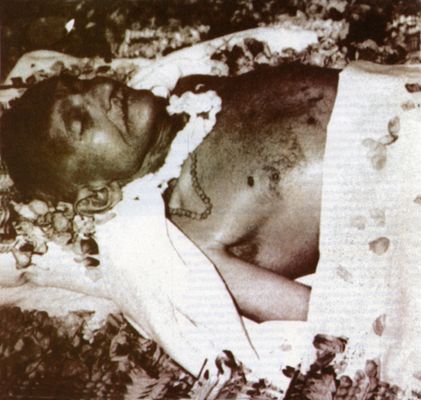 Holed at heart: Mahatma Gandhi after being shot.
Holed at heart: Mahatma Gandhi after being shot.
I am only concerned about Abhinav Bharat. I am not a blind follower of Savarkar. Period. Savarkar in 1906 wrote about 1857, spoke about Hindus and Muslims becoming blood brothers.
Savarkar’s views changed later.
I am concerned with his views expressed as a member of Abhinav Bharat. I am not concerned with his views expressed as a member of the Hindu Mahasabha or anything else.
You talk about a fourth bullet in the Gandhi murder. Investigators found three bullet entry wounds and two exit wounds.
Let’s be very specific. Three entry wounds, two exit wounds. So one bullet remained in the body.
Yes, so it is accounted for.
Yes, it was later recovered with the ashes, as no autopsy was performed. I hope you have read this book The Men Who Killed Gandhi [by Manohar Malgonkar].
Yes, I have. It’s a great work.
One bullet remained in the body, so it is accounted for. Two bullets, the DSP says he recovered. So all three bullets accounted for. So how did Manuben discover a bullet in the shawl at one in the night? This is the English translation of her handwritten diaries in Gujarati. I have got it from the National Archives in Delhi. “Around one o’ clock, Bapu was brought inside to bathe. While taking him to bathroom all started to cry. Bapu’s dhoti, shawl, handkerchief were covered with blood. From clothes one bullet came out.” This is contemporary record, written on January 31, 1948, by Manuben. Is she lying?
The Dawn in its headline says Four Shots. The Times of India and the Lok Satta reported four bullets, and you have this evidence from Manuben. So why have four bullets been converted into three? Who did that? Is it not a very material discrepancy in a murder trial?
Now let’s come to the Beretta pistol. Its chamber had seven bullets. The police found four live cartridges in it. So where did this fourth bullet come from? Not from this Beretta pistol, I am sure. Who is hiding this and why? Tushar Gandhi in his book Let’s Kill Gandhi makes a stunning allegation on page 77—that he was told that when Manuben was going to testify before the Kapur Commission, Morarji Desai called her and told her to tell the commission that she was too young at that time and she couldn’t remember. Manuben replied that she was a disciple of Gandhi and she would tell the truth and nothing but the truth.
I am not the first person who is alleging a cover-up. There was a gentleman from Goa who migrated to Portugal. He wrote a book, Who Killed Gandhi, in 1964 and it was banned in 1979.
Manuben testified before the Kapur Commission that Nathuram Godse had come in the afternoon on January 30. He stood right next to Gandhi and he could have killed him then. But, for some reason, he did not.
Alwar police records show that a foreigner sadhu distributed pamphlets at three in the afternoon saying Gandhi had been murdered. Those days we had cyclostyles. It is a process. So these pamphlets must have been printed an hour earlier. But, nothing happened to Gandhi at three in the afternoon. Who was this sadhu?
Then there is the testimony of Sarla Barve, wife of the collector of Poona. She mentions that a person called Sathe met her on January 27 or 28. He told her that he was worried that two or three people from Poona had gone to kill Gandhi. He also told her that some goondas of Poona were preparing to burn houses of Brahmins. Are these not enough to indicate that there was a larger conspiracy?
Which part of the Kapur Commission report are you objecting to?
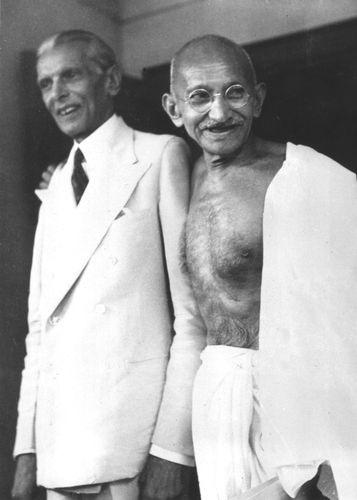 Father figures: Mahatma Gandhi and Muhammad Ali Jinnah | AP
Father figures: Mahatma Gandhi and Muhammad Ali Jinnah | AP
The Kapur Commission is destructive of every other theory than the theory to kill by Savarkar. He mentions it not in his findings, but in the observations. First of all, the Kapur Commission was barred by res judicata—matter already judged—to opine whether Savarkar was guilty or not. That was the job of the trial court or the High Court. Kapur was a retired judge. He was not a court of appeal. He could not rule on whether Savarkar was innocent or guilty. Secondly, he submitted his report in 1969. Savarkar was dead in 1966. So you condemn a man who is dead and whom you give no opportunity to defend himself.
The most objectionable part is in the findings where he maligns entire Marathi speaking people. He says that after Madanlal Pahwa was arrested, the police became somewhat complacent and they did not expect the escapee conspirators to display such speed and agility as was displayed by the Maratha army in the bygone days. Where does Maratha army come in this? Who do you associate Maratha army with? Shivaji Maharaj, right? Shivaji was dead in 1680. What is the relevance? Justice Kapur is a commission of inquiry, he has to go by evidence.
What he is trying to justify is the conduct of Deputy Inspector General U.H. Rana who was told on January 24 that people from Poona were trying to kill Gandhi. Rana doesn’t call up Poona, he does not fly to Poona. He takes a train from Delhi and goes to Allahabad. And that callousness is being justified by blaming Maratha army?
You claim there was another shooter?
I am assuming that there was another shooter because there is a fourth bullet which Godse’s pistol could not account for. So it is a deduction. I am saying there was organised effort.
By Force 136?
Yes. That is my allegation. I am only repeating the allegation made to Vijayalakshmi Pandit by the ambassadors in 1948.
What is the importance of the fourth bullet?
Do we not need to know who fired the fourth bullet? This material discrepancy of three and four bullets amounts to a huge cover-up. Could the motive not have been to derail Gandhi’s visit to Pakistan? Because he had got permission from Jinnah on January 27. Kuldeep Nayar’s account talks about Gandhi having readied 50 Punjabi families who were to travel with him and stay in Lahore. So Gandhi was trying to induce a reverse migration. Rajmohan Gandhi has written that, on January 16, Gandhi felt that all differences between India and Pakistan could be reconciled, including the problem of Kashmir. If the motive was to stop that, should that motive not become known to us? Is it irrelevant?
You have talked about US diplomat Herbert Tom Reiner.
The New York Times reported that Tom Reiner apprehended Godse with the help of others. I went to the US national archives. I found two telegrams.
* The first telegram said Gandhi had been shot.
* The second telegram, sent at 8pm, speaks about Reiner. That he was five feet away and he apprehended Godse along with Indian security people. Reiner returned to the embassy after the second telegram was sent. He gave a debriefing. That account was sent to the secretary of state later in the evening. I have not got that account. I asked for it, the third telegram. They said it is classified. I filed an appeal. I spoke to them over the phone about it last time I was there. They said it concerned the US national security interests. My question is, what does it have to do with the US national security? One Indian was killed by another Indian and it happened in India. How is US national security involved? Reiner seems to be some kind of US intelligence officer. Some 60,000 dollars were sent to him in May 1947. This is too much of a coincidence.
You have mentioned journalist Vincent Sheean’s words.
I have made an open appeal to Gandhi Smriti management: You are the people who put up that panel about “four dull dark explosions” [which Sheean wrote about]. It is right there outside the bedroom. So if it is untrue, tear it down or join me in the petition.
Do you dislike Gandhi?
No, no. I am critical of many of his policies. But I have written in my book that I consider Gandhi like my grandfather with whom I have differences.
Do you think Gandhi was right in insisting that Pakistan should be paid Rs 55 crore?
He was 100 per cent right. It is nothing but financial ignorance to suggest that we could have held on to those Rs 55 crore. That was their share.
Godse admitted that he fired the shots. There were 400 people present. How come no one other than Vincent Sheean heard this fourth shot ?
K.C. Roy [of Reuters] heard four shots. Two other reporters have reported likewise. There is a photo in The Hindu, published on January 31, 1948, where you can see four wounds. It’s a government photograph, PIB MG 2626.
Godse and Apte met Savarkar before they killed Gandhi.
Sir, it was prosecution claim, and prosecution failed to establish this.
Do you say Savarkar was not involved at all?
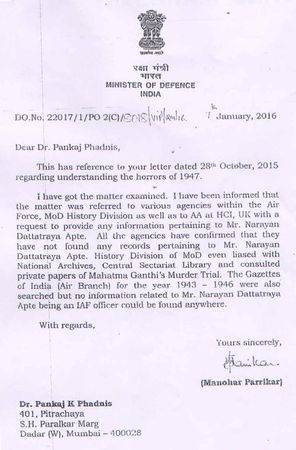 Missing officer: Defence minister’s letter about Apte not being in Air Force records.
Missing officer: Defence minister’s letter about Apte not being in Air Force records.
I have no reason to believe that he was involved. In the National Archives I discovered another interesting telegram. The US consul general Howard Donovan, based in Mumbai, had a meeting with the prosecution counsel C.K. Daphtary, sometime in 1948. Dapthary told Donovan that he had no evidence against Savarkar. He doesn’t know why his name has been included.
How many times are you going to condemn Savarkar? I read your magazine’s story on Savarkar [THE WEEK, January 24, 2016]. You have the right to criticise Savarkar. But let that be purely factual. Savarkar himself has written about his apology in his book. He has said it was a tactic. He did not leak any names of freedom fighters. So that apology has no meaning.
All legislators and ministers in the governments before independence had taken oaths declaring allegiance to the British Crown. This despite the fact that Quit India movement was launched in 1942 and Karenge Ya Marenge was the call. But, there is not a single word of criticism about this. Only three persons never took the oath—Netaji Bose, Gandhi and Savarkar.
Madanlal Pahwa was arrested by the Delhi police ten days before the assassination. He gave a statement to the police that editor of a Marathi paper in Poona was planning the killing. Yet the police could not prevent the killing. Why?
I suspect U.H. Rana, [Mumbai deputy commissioner of police] J.D. Nagarvala and [Intelligence Bureau director] T.G. Sanjevi were operatives of Force 136. These three were highly competent and professional officers. How come they suddenly become inefficient? Sanjevi, as the head of IB, just had to get the name and issue an arrest warrant. He did not do it. He tells Rana. Rana goes to Allahabad! Nagarvala is working on some kidnapping theory. Such incompetence is unbelievable. It was very strongly, adversely commented upon by the judge Atma Charan in the trial court.
Dr J.C. Jain had told [Bombay home minister] Morarji Desai that Madanlal and Vishnu Karkare were planning to kill Gandhi. Why didn’t the Bombay police make arrests?
The role of Morarji Desai as home minister is very strange. The Kapur Commission records that Narayan Apte was chargesheeted in July 1947 for being involved in a conspiracy to throw a hand-grenade. That chargesheet was withdrawn from the court. This is very strange.
Malgonkar’s book says Narayan Apte was a recruiting officer for Royal Indian Air Force.
The Kapur Commission also says he was in the Air Force. But I have a letter from defence minister Manohar Parrikar which says that there are no records of Apte being in the Air Force. The defence minister of India has access to all records, including those of the Royal Indian Air Force. Parrikar investigated.
What are the material facts that we do not know about the Gandhi murder? Do we know who supplied the Beretta pistol? Four people were chargesheeted for supplying the weapon—accused number 9, 10, 11 and 12. Dattatraya Parchure, number 9, was acquitted. Accused number 10, 11 and 12 were never arrested. Once Parchure was acquitted, they surrendered and got discharged. So on record who supplied the pistol?
Wasn’t it J.P. Goel, the arms dealer?
That is even more strange. Goel admitted, as a prosecution witness, that he owned the pistol and that it was unlicensed. Because he had no documents to show it was his pistol. If you own an unlicensed weapon with which the Father of the Nation was murdered, are you not liable for prosecution? Why was Goel never prosecuted? There are so many mysteries.
According to you, what was Apte ?
In all probability he was a Force 136 operative. Apte and Godse were two very different people. Godse wanted to die. Apte wanted to live.
Both were staunch hindutva fanatics.
Apte had two wives. One of them, Manorama Salvi, was a Marathi Christian. So you have a devoted hindutva person marrying a Christian girl and fathering a child? Does it fit in?
Men are like that.
Apte never confessed to his crime. He went in appeal. Was Apte not entitled to have the Supreme Court of India hear his claim of innocence? He appealed to the Privy Council [the court of appeal for the British colonies]. The Privy Council returned the paper saying it was going to lose its jurisdiction. That was on October 26, 1949. Then how come he was executed on November 15, 1949 without waiting for [the Supreme Court of India to come into being on] January 26, 1950? What was the tearing hurry? He had two children, one mentally challenged, another a one-year-old girl.




